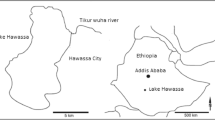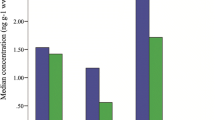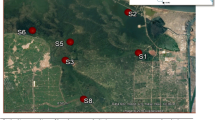Abstract
The Irrawaddy dolphin (Orcaella brevirostris) is at risk of extinction throughout its range as a result of incidental catches, habitat degradation, and pollution. Populations of Irrawaddy dolphins are constrained by the species’ narrow habitat requirement—lagoons, estuaries, rivers, and lakes—and are therefore particularly vulnerable to the effects of human activities. In this study, for the first time, concentrations of organochlorine (OC) pesticides, polychlorinated biphenyls (PCBs), and polybrominated diphenyl ethers (PBDEs) were determined in tissues of Irrawaddy dolphins collected from Chilika Lake, India, to understand the status of contamination. Dichlorodiphenyltrichloroethane and its metabolites (DDTs) were the predominant contaminants found in Irrawaddy dolphins; the highest concentration found was 10,000 ng/g lipid weight in blubber. Hexachlorocyclohexanes (HCHs) were the second most prevalent contaminants in dolphin tissues. Concentrations of PCBs, chlordanes, hexachlorobenzene, tris(4-chlorophenyl)methane, and tris(4-chlorophenyl)methanol were in the ranges of few ng/g to few hundreds of ng/g on a lipid-weight basis. In general, concentrations of OC pesticides and PCBs in Irrawaddy dolphins were lower than the concentrations reported for coastal and riverine dolphins collected in Asia. PBDEs were detected in the blubber of Irrawaddy dolphins at concentrations ranging from 0.98 to 18 ng/g lipid weight. BDE congener 47 accounted for 60% to 75% of the total PBDE concentrations. Although these results establish the baseline levels of persistent organic pollutants in Irrawaddy dolphins, efforts should be made to decrease the sources of contamination by DDTs and HCHs in Chilika Lake.



Similar content being viewed by others
References
Colborn T, Smolen MJ (1996) Epidemiological analysis of persistent organochlorine contaminants in cetaceans. Rev Environ Contam Toxicol 146:91–172
Dhandapani P (1992) Status of Irrawaddy river dolphin, Orcaella brevirostris, in Chilka Lake. J Mar Biol Assoc India 34:90–93
Jepson PD, Bennett PM, Deaville R, Allchin CR, Baker JR, Law RJ (2005) Relationships between polychlorinated biphenyls and health status in harbor porpoises (Phocoena phocoena) stranded in the United Kingdom. Environ Toxicol Chem 24:238–248
Kajiwara N, Matsuoka S, Iwata H, Tanabe S, Rosas FCW, Fillmann G, et al. (2004a) Contamination by persistent organochlorines in cetaceans incidentally caught along Brazilian coastal waters. Arch Environ Contam Toxicol 46:124–134
Kajiwara N, Ueno D, Takahashi A, Baba N, Tanabe S (2004b) Polybrominated diphenyl ethers and organochlorines in archived northern fur seal samples from the Pacific coast of Japan, 1972–1998. Environ Sci Technol 38:3804–3809
Kannan K, Tanabe S, Borrell A, Aguilar A, Focardi S, Tatsukawa R (1993a) Isomer-specific analysis and toxic evaluation of polychlorinated biphenyls in striped dolphins affected by an epizootic in the western Mediterranean Sea. Arch Environ Contam Toxicol 25:227–233
Kannan K, Sinha RK, Tanabe S, Ichihashi H, Tatsukawa R (1993b) Heavy metals and organochlorine residues in Ganges river dolphins from India. Mar Pollut Bull 26:159–162
Kannan K, Tanabe S, Tatsukawa R, Sinha RK (1994) Biodegradation capacity and residue pattern of organochlorines in Ganges river dolphins from India. Toxicol Environ Chem 42:249–261
Kannan K, Tanabe S, Tatsukawa R (1995) Geographical distribution and accumulation features of organochlorine residues in fish from tropical Asia and Oceania. Environ Sci Technol 29:2673–2683
Kannan K, Senthilkumar K, Sinha RK (1997) Sources and accumulation of butyltin compounds in Ganges river dolphin, Platanista gangetica. Appl Organomet Chem 11:223–230
Kannan K, Blankenship AL, Jones PD, Giesy JP (2000) Toxicity reference values for the toxic effects of polychlorinated biphenyls to aquatic mammals. Human Ecol Risk Assess 6:181–201
Karuppiah S, Subramanian A, Obbard JP (2005) Organochlorine residues in odontocete species from the southeast coast of India. Chemosphere 60:891–897
Law RJ, Allchin CR, Mead LK (2005) Brominated diphenyl ethers in the blubber of twelve species of marine mammals stranded in the UK. Mar Pollut Bull 50:344–359
Minh TB, Prudente MS, Watanabe M, Tanabe S, Nakata H, Miyazaki N, et al. (2000) Recent contamination of persistent chlorinated endocrine disrupters in cetaceans from the North Pacific and Asian coastal waters. Wat Sci Technol 42:231–240
Perrin WF, Brownell RL Jr, Kaiya Z, Jiankang L (1989) Biology and conservation of the river dolphins. In: Perrin WF, Brownell RL Jr, Kaiya Z, Jiankang L (eds) Proceedings of the Workshop on Biology and Conservation of the Platanistoid Dolphins. Wuhan, China, October 28–30, 1986
Reeves RR, Chaudhry AA, Khalid U (1991) Competing for water on the Indus plain: Is there a future for Pakistan’s river dolphins? Environ Conserv 18:341–350
Reeves RR, Chaudhry AA (1998) Status of the Indus river dolphin Platanista minor. Oryx 32:35–44
Reeves RR, Leatherwood S (1994) Dams and river dolphins: Can they co-exist? Ambio 23:172–175
Reijnders PJH (1986) Reproductive failure in common seals feeding fish from polluted coastal waters. Nature 324:456–457
Renjun L (1990) New advances on population status and protective measures for Lipotes vexillifer and Neophocaena phocaenoides in the Changjiang River. Aquat Mamm 17:181–183
Reyes JC (1991) The conservation of small cetaceans: A review. Report prepared for the Secretariat of the Convention on the Conservation of Migratory Species of Wild Animals. UNEP / CMS Secretariat, Bonn, Germany
Sahu HK, Kar SK, Patnaik SK (1998) Study on some aspects of Irrawaddy river dolphin Orcaella brevirostris gray in Chilika Lake, Orissa. Indian Forest 24:803–809
Senthilkumar K, Kannan K, Sinha RK, Tanabe S, Giesy JP (1999) Bioaccumulation profiles of polychlorinated biphenyl congeners and organochlorine pesticides in Ganges River dolphins. Environ Toxicol Chem 18:1511–1520
Sinha RK (2004) The Irrawaddy dolphins (Orcaella brevirostris) of Chilika lagoon, India. J Bombay Nat His Soc 101:244–251
Smith BD, Haque AKMA, Hossain MS, Khan A (1998) River dolphins in Bangladesh: Conservation and the effects of water development. Environ Manage 22:323–335
Tanabe S, Watanabe S, Kan H, Tatsukawa R (1988) Capacity and mode of PCB metabolism in small cetaceans. Mar Mamm Sci 4:103–124
Tanabe S, Subramanian AN, Ramesh A, Kumaran PL, Miyazaki N, Tatsukawa R (1993) Persistent organochlorine residues in dolphins from the Bay of Bengal, South India. Mar Pollut Bull 26:311–316
Turek KJS, Kucklick JR, Becker PR, Stapleton HM, Baker JE (2005) Persistent organic pollutants in two dolphin species with focus on toxaphene and polybrominated diphenyl ethers. Environ Sci Technol 39:692–698
Ueno D, Kajiwara N, Tanaka H, Subramanian A, Fillman G, Lam PKS, et al. (2004) Global pollution monitoring of polybrominated diphenyl ethers using skipjack tuna as a bioindicator. Environ Sci Technol 38:2312–2316
Watanabe M, Kannan K, Takahashi A, Loganathan BG, Odell DK, Tanabe S, et al. (2000) Polychlorinated biphenyls, organochlorine pesticides, tris(4-chlorophenyl)methane and tris(4-chlorophenyl)methanol in livers of small cetaceans stranded along Florida coastal waters, USA. Environ Toxicol Chem 19:1566–1574
Ylitalo GM (2005) The role of organochlorines in cancer-associated mortality in California sea lions (Zalophus californianus). Mar Pollut Bull 50:30–39
Acknowledgments
This study was supported by Grants-in-Aid for Scientific Research (Grant No. 16201014) from Japan Society for the Promotion of Science and for Young Scientists (Project No. 16780139) and the 21st Century COE Program from the Ministry of Education, Culture, Sports, Science and Technology of Japan.
Author information
Authors and Affiliations
Corresponding author
Rights and permissions
About this article
Cite this article
Kannan, K., Ramu, K., Kajiwara, N. et al. Organochlorine Pesticides, Polychlorinated Biphenyls, and Polybrominated Diphenyl Ethers in Irrawaddy Dolphins from India. Arch Environ Contam Toxicol 49, 415–420 (2005). https://doi.org/10.1007/s00244-005-7078-6
Received:
Accepted:
Published:
Issue Date:
DOI: https://doi.org/10.1007/s00244-005-7078-6




